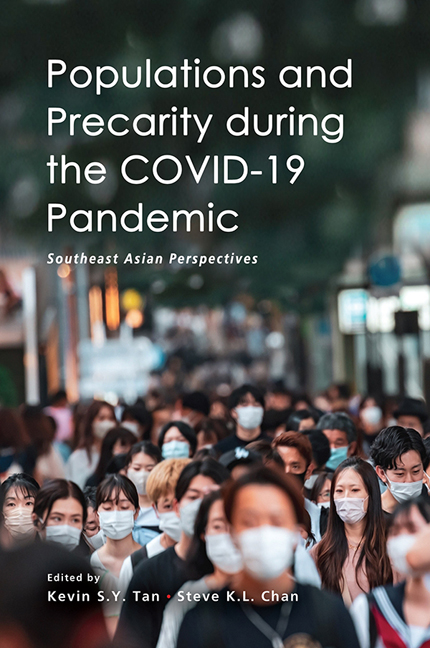Book contents
- Frontmatter
- Contents
- Preface
- About the Contributors
- 1 Introduction: Populations, Precarity and the COVID-19 Pandemic
- 2 Transformation of the Family Structure in Southeast Asia: Trends and Implications
- 3 New Normal, Old Ties: COVID-19’s Social Impact on the Singapore-Johor Bahru Connection
- 4 Unequal Flows: Examining the Factors Surrounding Thai and Vietnamese Labour Migration to South Korea
- 5 Emplacing Multiculturalism: Southeast Asian Migrant Linguistic Acculturation Programmes and Community Building in South Korea
- 6 “Foreign Talent” in Singapore and Some Implications for Schools
- 7 Managing Disaster Risk and Enabling Social Protection in Thailand: Some Lessons from the COVID-19 Pandemic
- 8 Transnational Housing Insecurity: Mobility, Homelessness, and the COVID-19 Pandemic
- 9 Older Persons with Hearing Disabilities in Indonesia: Vulnerability and Demographic Diversity during the COVID-19 Pandemic
- Index
9 - Older Persons with Hearing Disabilities in Indonesia: Vulnerability and Demographic Diversity during the COVID-19 Pandemic
Published online by Cambridge University Press: 01 March 2024
- Frontmatter
- Contents
- Preface
- About the Contributors
- 1 Introduction: Populations, Precarity and the COVID-19 Pandemic
- 2 Transformation of the Family Structure in Southeast Asia: Trends and Implications
- 3 New Normal, Old Ties: COVID-19’s Social Impact on the Singapore-Johor Bahru Connection
- 4 Unequal Flows: Examining the Factors Surrounding Thai and Vietnamese Labour Migration to South Korea
- 5 Emplacing Multiculturalism: Southeast Asian Migrant Linguistic Acculturation Programmes and Community Building in South Korea
- 6 “Foreign Talent” in Singapore and Some Implications for Schools
- 7 Managing Disaster Risk and Enabling Social Protection in Thailand: Some Lessons from the COVID-19 Pandemic
- 8 Transnational Housing Insecurity: Mobility, Homelessness, and the COVID-19 Pandemic
- 9 Older Persons with Hearing Disabilities in Indonesia: Vulnerability and Demographic Diversity during the COVID-19 Pandemic
- Index
Summary
Introduction
The outbreak of COVID-19 in 2019 has affected the quality of life of individuals all over the world. The direct effects include being infected by the virus, whether asymptomatic, pre-symptomatic, or being severely ill and even loss their life. Family suffering, financial loss, and the inability of health facilities to accommodate the rapidly rising cases have aggravated the misery of those being exposed to the virus.
The indirect effects are experienced through various health protocols, including restrictions on population mobility and universal face masking to limit the spread of the virus. These indirect effects may influence people's livelihood, day-to-day behaviour, and mental health. The vulnerable groups (such as the poor, older persons, pregnant women, and persons with disabilities) may suffer much more, facing difficult choices between being exposed to the virus by continuing their usual daily activities or going hungry by staying at home and losing their income.
Among these vulnerable groups, older persons with a hearing disability may suffer more. Policies to curb the spread of infection bring difficulties in face-to-face communication for persons with hearing disabilities (Sher et al. 2020). The mask muddles sound and hides the movement of the lip (Trecca et al. 2020; Huzlen and Fabry 2020). Physical distancing also prevents people with hearing disabilities from communicating well with others as distance reduces the clarity of voice (Huzlen and Fabry 2020). Furthermore, restriction on meeting other persons physically results in having fewer opportunities to obtain assistance in daily conversation.
Therefore, older persons with hearing disabilities are much more precarious, vulnerable and marginalized than others during the COVID-19 pandemic. The challenges are accentuated in the absence of affordable effective hearing aids and limited or even non-existence of sign language.
Nevertheless, hearing disability during the pandemic is one of the most often neglected topics in research and policymaking, although the disability has far-reaching consequences on the quality of life (Nuesse et al. 2021), prosperity of the community, and government policies (WHO 2021; McDaida et al. 2021). This study examines the magnitude and prevalence of hearing disability among older persons, their demographic diversity and hearing disability impacts on the quality of life.
- Type
- Chapter
- Information
- Populations and Precarity during the COVID-19 PandemicSoutheast Asian Perspectives, pp. 144 - 166Publisher: ISEAS–Yusof Ishak InstitutePrint publication year: 2023

